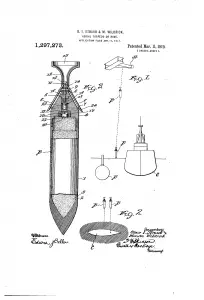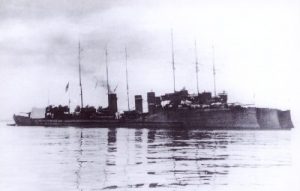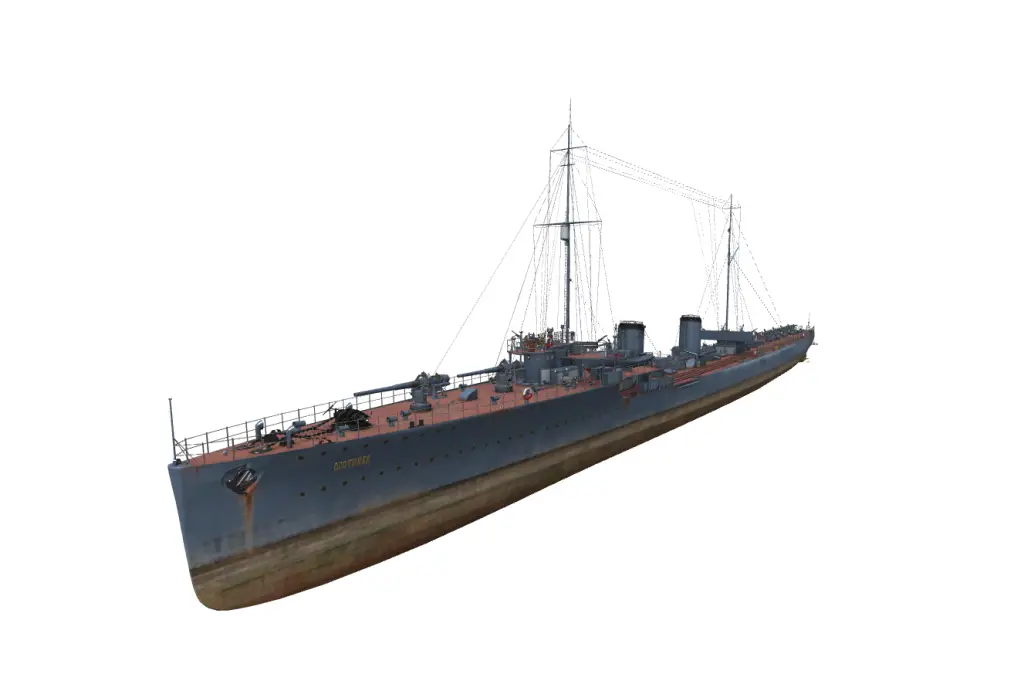The ship was patrolling an anchorage in the Baltic Sea on 26 September, 1917. The Germans had been softening up the Russian forces in the area for what both sides expected would be an offensive against the Russian-occupied seacoast. German naval air forces, which had air superiority, conducted aerial bombing from airplanes and Zeppelines. They destroyed the magazine of one shore battery with a lucky hit, a fire, and secondary detonations. German land-based naval aviation attacked Russian ships with torpedoes, and scattered mines. The torpedoes had mechanical problems; the mines, too, had yet to score.
As luck would have it, the ill-fated Okhotnik and her ill-fated skipper, Lieutenant Second Rank V.A. Fok, went down in history as their ship went down in the Baltic, first naval vessel sunk by an air-deployed mine. And Fok went down with his ship, a testament to the collapsed discipline of the revolutionary Russian armed forces (this was the Provisional Government period).
As the Russian torpedoboat destroyer Okhotnik carried out picket duty in the manoeuvre basin near buoy number 4 on 26 September, she struck a German mine. This mine had been laid by a German aircraft and Okhotnik carried the dubious distinction of being the first warship sunk by an aerial mine. Neither the commander nor officers wished to abandon ship. Harald Graf described the situation as follows:
Soon all the boats were overflowing with sailors and nobody thought to offer the officers a place. They considered it improper to ask for a place and remained aboard the torpedoboat, silently observing the leaving of the boats. The torpedoboat sank, and soon water flooded over the deck on which the officers stood….
With Okhotnik two more officers were lost, the commander Senior Leitenant V A Fok, and Leitenant V K Panferov.1

We’re still looking for information on German air-delivered mines of WWI. But this US patent was granted in 1917.
This first effective use of aerial mines was far from the last; air-laid mines would sink hundreds of ships in the Second World War. But given the Baltic’s situation as a forgotten theater of World War One, this far-ranging and effective German air-sea campaign is practically unknown today. In a master’s thesis for the Air University in 1992, USAF Major John Chilstrom, an FB-111 and B-52 strategic bomber commander, did a deep dive into aerial mining history, but while he credited the Germans for kicking the technology off, he missed his target by one war:
In World War II, the Luftwaffe was first to lay mines from the air and first to field many of the weapon’s innovations.2
The first recorded aerial minelaylng in combat occurred on November 20. 1939, when nine Heinkel 59 floatplanes flew to the Thames Estuary. Although five turned back due to navigation difficulties, four aircraft laid seven mines that night and thirty-four more in the following two days.
However, two of the mines dropped on the third attempt fell in shallow water, enabling the British to recover examples of Germanyís “secret” weapon-the magnetic mine. “Britain had captured her biggest prize since the war began.” 3
While that could be read as giving the Germans credit only for being first in World War II, nowhere else in the manuscript does he credit WWI with aerial mines. This is not to discredit Chilstrom’s work overall; it’s an engaging history of a little-studied aspect of World War II, and has direct applications to the future.
Notes
- Staff, p. ? (using an electronic copy lacking page numbers).
- Chilstrom, p. v.
- Chilstrom, p. 7.
Sources
Chilstrom, John S. (Major, USAF). Mines Away! The Significance of US Army Air Forces Minelaying in World War II. Maxwell AFB, Alabama: Air University, 1992. Retrieved from: https://permanent.access.gpo.gov/websites/dodandmilitaryejournals/www.maxwell.af.mil/au/aul/aupress/SAAS_Theses/SAASS_Out/Chilstrom/chilstrom.pdf
Staff, Gary. Battle for the Baltic Islands: Triumph of the German Navy. Barneley, S. Yorks: Pen and Sword Maritime, 2008.

Kevin was a former Special Forces weapons man (MOS 18B, before the 18 series, 11B with Skill Qualification Indicator of S). His focus was on weapons: their history, effects and employment. He started WeaponsMan.com in 2011 and operated it until he passed away in 2017. His work is being preserved here at the request of his family.



21 thoughts on “An Unwanted First for the Destroyer Okhotnik”
On the SIG P320 XM17 item, John Richardson’s post on the topic on the No Lawyers – Only Guns and Money blog, says:
John Farnam has more information on the military version of the P320 or the XM17 along with some commentary about the changes in his Farnam’s Quips email.
Friends as (sic) SIG tell me these additional details about the pistol that will ultimately be delivered to the Army:
Our military’s version of SIG’s 320 pistol will have a manual safety lever. Of course, most troopers will never be allowed to even have a magazine inserted into the pistol, much less carry the weapon with a round chambered, so the manual safety lever will have little real function.
Two more “enhancements:”
The take-down lever will be “secured” in some way on the right side, so that it cannot be removed at the field level which would allow complete removal of the fire-control unit from the plastic frame.
The slide cover-plate at the back will be “secured” in a similar fashion, and for the same reasons.
Army procurement people obviously do not want “end-users” (the ones who may actually have to shoot someone) taking the gun apart any further than field stripping.
I carried a SIG320 for most of last year. My copy has no manual safety, as I have no interest in one and consider it a mostly useless and unnecessary addition. If I were carrying a 320 with a manual safety, I’d leave it in the “off” position. However, a manual safety that does not exist cannot be inadvertently left in the “on” position, and that is why I like it gone!
Not everyone agrees, however.
“There is nothing so useless as doing efficiently what need not be done at all”
(http://onlygunsandmoney.blogspot.com/2017/01/great-news-for-sig-sauer.html)
Thanks for sharing this. I never knew the Germans used air dropped mines in WW I. Is there a list somewhere of “first ship sunk by X”? Offhand that would include Viribus Unitis (first use of frogmen), Housatonic (first by submersible) and Eilat (first by surface to surface to surface missile).
Great post! I did not know this either and have read a book or two on the Baltic in WWI. The naval and amphibious operations the Germans staged in the Baltic in the later parts of WWI make for very interesting reading. Bike troops, assault troops, combined air-land-sea ops, etc.
https://shipwreckology.com/2012/10/12/battle-in-the-baltic-operation-albion/
Oh, great link! The book I got it from is cited in the post: Gary Staff’s Battle for the Baltic Islands: Triumph of the German Navy.
Fascinating, forgotten theater, in both world wars. Russian submarine operations are interesting. Russian WWI subs did not have any watertight compartments!
Russian engineering: “Is easy to fix! See? Look. I fix.”
-John M.
The thing you have to remember about Russian engineering is that while there is a lot of what you describe… There is also the bits and pieces of it where it is enormously sophisticated and well worth respecting.
Russia is one of those culture/nationalities where you have to be very careful about just which aspect of it you’re dealing with-At the same time that they can be incredibly dumb and gullible, in terms of what they’ll buy in the intelligence realm, they’re also capable of being amazingly cunning and guileful with other things-And, sometimes at the same damn time, in the same operation.
Examples abound-Mig-25 comes to mind, as one.
The other realm to watch with the Russians is where they demonstrate enormous reserves of deep, penetrating thought on issues we here in the West just wing it. Ever read any real Soviet military doctrine? The level of systematization and deep thought that went into some aspects of that stuff is truly amazing, and far beyond any of the theoretical underpinnings of our own work in that area. What’s tragic is that you have all this sophistication married to feet of clay, when it comes to execution. Manufacture rarely matches the engineering, and the army that conceptualized sophisticated artillery and deception plans couldn’t even keep its own troops watered and fed, or maintain a high enough standard of field hygiene to prevent the scourges of 19th Century military plagues like cholera or typhus in Afghanistan.
Russia is one of those countries you just have to stand well back from, hope to God you’ve got them on your side in a war, and try not to get hit with the backsplatter from it all, when things go wrong for them. When it goes right, they’re bloody unstoppable. When it goes bad…? Yeah. Ask a Russian about the Finns…
“Ask a Russian to design you a pair of shoes and he’ll give you something that looks like the box shoes come in. Ask him to design something to kill Germans and he turns into Thomas Edison.” – Neal Stephenson
(from memory)
Baldrick too had “cunning” ideas, from the brilliant to the inane. 😀
I realize you’re joking, but Russian engineers are really good at being cost effective. True anecdote from the early days of manned spaceflight:
American Engineer: “Regular pens won’t work in zero gravity. I guess we’ll spend millions to design a pen that will!”
Russian Engineer: “Regular pens won’t work in zero gravity. I guess we’ll use a pencil.”
Actually the whole “Russians used a pencil” thing is not true. Yanks used a pencil too; the zero-G pen was a private development and the company, once they had a working product, gave them to NASA. Whatever it cost, it cost them, not the taxpayers; and they made it back from space geek kids like me who bought one of the pens for conversation value.
I’ve still never been at zero-G for more than a few seconds, and was too busy flying the plane to write anything.
What Hognose said… Plus, loose graphite in zero-g is a bit of a fire hazard, when the bits find a circuit to bridge. From what I’ve read, pencils are actually banned as fire hazards aboard spacecraft, if you’ve got any sense.
I stand corrected. The fire hazard concern makes sense; I remember putting voltage across pencil lines on paper when I was a kid…
A lot of the early subs lacked them. The RN, for one, did not have them untill the E-Class, nor the Hollands, nor the Ds had them. Submarining was all or nothing back then. That Adm Horton quote about the room for errors in submarines? Guess where he figured that out…
QUALIFICATIONS: ZERO/NIL/NO SF/SO training or experience, but 51 months Jump Status in “America’s
Guard of Honor”-The 82d Airborne Division, beginning in the Mr James E (“Jimmy”) Carter-era “Hollow Army”.
RE Air-delivered Naval Mines: The US Army developed a helicopter-droppable version of the Navy’s Encapsulated Homing Torpedo (ENCAPTOR), called Mobile Water Mine (MOWAM) in the early 1970s.
This was developed at the Corps of Engineer Waterways Experiment Station, at Vicksburg.
This was intended to frustrate Warsaw Pact river crossings in Europe.
MOWAM could be emplaced by hand (from an RB15, etc.) or free-dropped from a UH-1 or CH-47.
The fun/nightmarish thing about mines is that they are
-A) very cheap,
-B) very easy to lay, and
-C) Work even as a threat (eg to be effective you don’t even have to lay them, just either make your enemy think you lay them or demonstrate an ability to lay them.
Recently read Lee Allen Zatarain’s book Tanker Wars, which discussed our scraps with the Iranians in the 1980s. Mine warfare was a big part of those scraps, as USS SAMUEL B. ROBERTS demonstrated
#1 son went in the Navy as an aerographer. He was impressed, in the naval sense, into service as a countermine warfare sailor. That field had been so long neglected they hired retirees back to start it up. He has some hysterically funny stories about the learning curve of junior officers on Unmanned Underwater Vehicles. Evidently the GPS will still function even if the UUV has been scarfed up off the beach and loaded into a car.
#1 was not optimistic about finding mines in the debris on the bottom along coasts.
The program ran for a few years and went away. Last I heard we were outsourcing countermine to the Danes.
One wonders how that will work IVO President Trump’s statements on NATO.
The Baltic is truly one of the most interesting secondary fronts of the Great War. I was aware of the incident but not about Chilstrom’s book.
Pity it does not cover the German airmining warfare against the Russian trafic in the Volga during WWII, the closest thing the Luftwaffe was ever going to be from a truly strategic operation, but I will certainly give it a look. The prospects seem quite bright for a winter weekend of reading.
Kudos!
The Luftwaffe also put a lot of effort into dambusting, with a view to destroying specific hydroelectric installations on the Volga and other rivers that Soviet industry, which was much more concentrated than German or Allied industry, depended upon. I have a half-written post on that somewhere.
Well, it was more concentrated until Stalin had it carried brick-by-brick to Tashkent and other places east of the Urals.
-John M.
The commander – Senior Lieutenant V.A. Fock
Acting senior officer Lieutenant G.V.Ogilvi
Mine officer Lieutenant V.K.Panferov
Watchman Chief Ensign V.I.Lebedev